 TRANSPORT: LINKING ROADS TO DEVELOPMENT TRANSPORT: LINKING ROADS TO DEVELOPMENT |
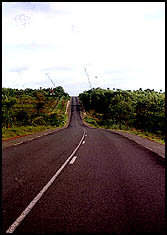
One of Guinea's main focuses the development of its infrastructure, as it is the only road to complete economic development. The Transport sector has thus undergone many changes since the birth of the Second Republic in 1984. The minister of public works and transport, Mr. Cellou Dalein Diallo specifies that "the Guinean government has made enormous efforts to make this sector performant, since we know that only a country possessing transport conditions can attract foreign investors. Investors must be sure that they can move their goods efficiently and rapidly, in order to assure productivity and the well functioning of their activities."
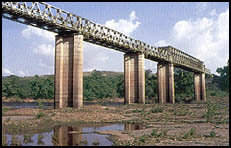
In accordance with the Minister is the General Director of the Port of Conakry, Mr. Aliou Diallo who affirms that "the government is leading an open door policy in order to attract more investors from abroad. In this view, the government has invested in the improvement of airport conditions in terms of navigation, assistance, and technical performance in order to make it internationally competitive." Technical assistance in this sub-sector is assured by SOGEAC, a private company in which theGovernment holds 50%. The government is looking to define the necessary investments to increase air traffic from its annual 300 000 passengers. One of the main ways for this to happen is for the country to increase the number of tourists visiting Guinea.
The national carrier, Air Guinea, occupies a preponderant position in the sector of air transport. Created on December 30, 1960, the airline assures domestic and regional travel of passengers and cargo, with regular flights to Bamako, Accra, Banjul, Dakar, Abidjan, Kinshasa, Monrovia, Freetown and Lagos, and is also the official carrier of the President. In 1984 Air Guinea possessed a Boeing 737 and 727 as well as a DACH with 50 seats. Today, however, it is only in possession of its Boeing 737 and a Y 700, used solely for domestic flights. They carry an average of 45 000 passengers a year and its turnover is between 8 and 10 million dollars.
A state run airline with 250 trained employees, Air Guinée is evolving rapidly. Its General Director is convinced about the fact that the "future development of Air Guinée can only be assured through a strategic partner, capable of sustaining its development in return of common exploitation of landing rights on the international network".
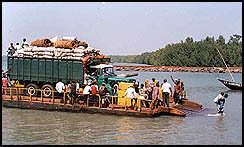
Maritime transport is essential in Guinea. The Autonomous Port of Conakry (PAC) is one of the success stories of Guinea. Until 1982 the Port did not go through many changes. It was development agencies such as the World Bank, the French Agency for Development and that BAD that began two 100 million dollar projects in order to expand the Port. These projects "have permitted to renew the depots, the Ports dock, the docks pavement, and to construct a new container terminal of 8 ha and a installed capacity of 54 TEU or 54 million containers of 20 feet TEU", exclaims Mr. Diallo. The ports administration is in charge of the management of the goods and people, of the piloting as well as the towing of ships at the entry to and the exit from the Port, the management of contracts with the users, and its maintenance. The PAC manages the concessions of the main companies in Guinea: Friguia for the export of alumina, SBK for the export of Bauxite, the Grand Moulins de Guinée (GMG) for the import of wheat and the export of flour, and Ciments de Guinea for the imports of clinker. The port's traffic was in steady progression during the 1980's, reaching 5 million tons per year. Nevertheless, due to the Guinea's recessionary period and the difficulties FRIGUIA and SBK were experiencing representing 60% of the Ports traffic the Port decreased its processing from 3 million tons to 1.4 million tons per year. "In terms of tariffs, the Port of Conakry is at a par with the tariffs instilled in Dakar and Abidjan", stresses Mr. Diallo. The Port of Conakry, "is going through its third phase of restauration , comprising the extension of the container terminal over 10 Ha, which should eradicate the saturation of its infrastructure that the PAC is facing today", he says. This new installation will increase the capacity of the Port remarkably and maybe even double it. | The second issue for the Port is the construction of a 500ha zone that will create a surface on which to build a larger warehouse for its operators. The total cost of this project comes close to 73 million dollars, which will be funded by the various lending institutions. In conjunction with this project, the road from Kankan to Kouremali which is the last portion of the road connecting Conakry to Bamako in Mali is also being restored. The General Director reminds us that "with this in place, we will be able to capture 10% of the traffic from", which is important, as Conakry is more accessible and closer to Bamako than Dakar.
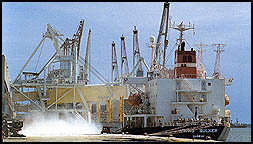
The Naval Company of Guinea also participates in the maritime transport with activities of consignation, maintenance and transit. Created in 1968, the SNG disposed of ships with the sole purpose of shipping minerals, a tugboat, and a refrigerated ship. The SNG evolved within a centralized economy with little efficiency, which is why it changed its status and privatized its activities in 1987. Foreign ship owners associated themselves with SNG and created a new structure known today as SOGUICOM of which SNG holds 40%. With a capital of 180 000 USD and a total turnover of more than 700,000 USD, the company recorded last year profits in the range of 145,000 USD. Giants such as MAERSK or SDV (Bollore group) are having a determining impact on the transport market creating a drop of 60% of SOGUICOM's turnover in the first trimester of the year 2000 after buying out its principal client PACOLINER by MAERSK. At the same time SDV reinforced its position in the market by taking over SAGASOEM.
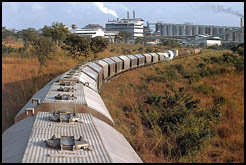
If maritime transport is one of the most promising sectors for the development of Guinea, with a growth between 3 and 5% according to analysts, it is quite the opposite for railway transport. Excluding the railway networks CBG, SBK and Friguia with 178km, 87km, and 87km of rails respectively, there is no railway destined to the transport of passengers. It is only since May 200 that the trains of "tanka" have restarted to circulate 20km around Conakry. "There is no doubt that the creation of a new railway system would permit more mobility of the population between the major cities", agrees the minister of transport. Finally the Bauxite Company of Dabola is directly concerned with this issue as the interruption of the railway system in the area has caused delays in the ability to exploit and transport its Bauxite reserves to the Port.
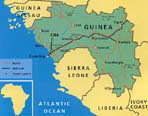
Click to enlarge (157 ko)
A final aspect concerning this sector and definitely not the least important is that of road transport. The development of roads has seen incredible expansion during the last decade. The transport of goods and people in the interior of the country is a development vector for commerce and their necessary exchanges. More than 70 000 vehicles transport people, agricultural products, and general goods from Conakry to the 33 prefectures of the country. Between trucks carrying 20 to 40 tons, passenger buses, cars and other modes of road transport traffic is dense. This is a problem in the entire country. The main rural villages can be reached and accessible by asphalt roads which are in regrettable states and are being repaired slowly. |

